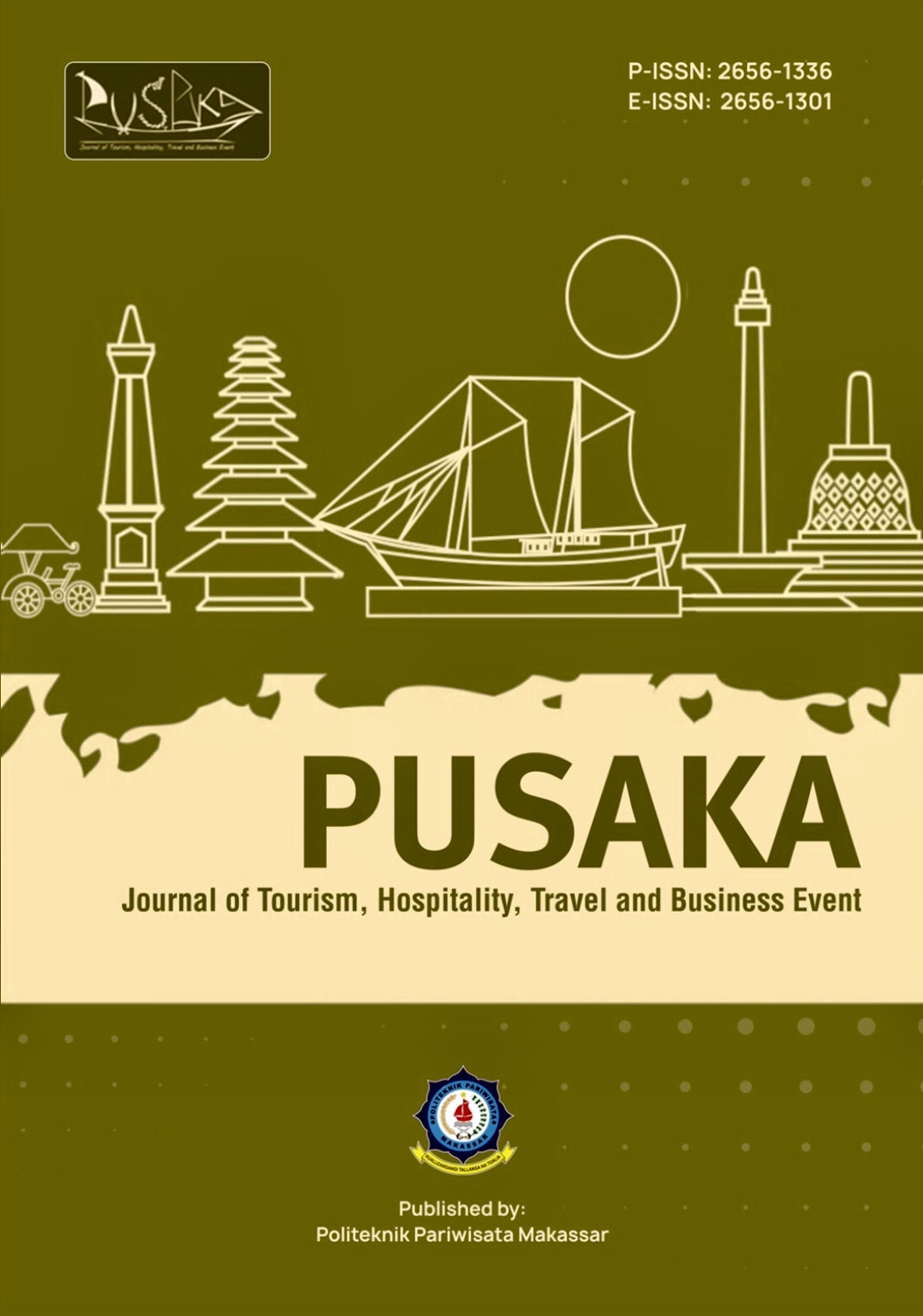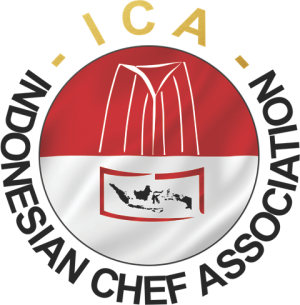Fostering The Indonesian Culinary Through Language and Visual on Social Media: Tourism Discourse Perspective
DOI:
https://doi.org/10.33649/pusaka.v5i2.255Keywords:
Culinary, Language; Images, Attraction, TourismAbstract
The growth of culinary tourism has become a tourist attraction in many countries worldwide. Culinary is important in endorsing the uniqueness and authenticity of the country and nation. This paper investigates the role of language and visual images in fostering Indonesian cuisine on social media, Facebook, Instagram, and Twitter in multimodal perspectives. This research adopted multimodal discourse analysis to manipulate the data gained. The study focuses on the language and visual elements employed in social media. The choice of words and stylistic strategies on Facebook, Instagram, and Twitter become the concern of the analysis. The main visual analysis concerns are modality, participant and salience. The find shows that social media relies heavily on exaggerated language and images to foster culinary tourism in Indonesia. It thus contributes to our understanding of how multimodal discourse about Indonesian culinary tourism develops with changing Indonesian tourism.
References
Aquino, R. S., Lück, M., & Schänzel, H. A. (2018). A conceptual framework of tourism social entrepreneurship for sustainable community development. Journal of Hospitality and Tourism Management, 37, 23–32. https://doi.org/https://doi.org/10.1016/j.jhtm.2018.09.00 1
Arora, A., Bansal, S., Kandpal, C., Aswani, R., & Dwivedi, Y. (2019). Measuring social media influencer indexinsights from facebook, Twitter and Instagram. Journal of Retailing and Consumer Services, 49, 86–101. https://doi.org/https://doi.org/10.1016/j.jretconser.20 19.03.012
Berger, P. L., & Luckmann, T. (1991). The Social Construction of Reality: Treatise in the Sociology of Language (10th ed.). Penguin Books.
Björk, P., & Kauppinen-Räisánen, H. (2016). Local food: a source for destination attraction. International Journal of Contemporary Hospitality Management, 28(1), 177– 194. Burr, V. (1995a). An introduction to social constructionism. In An introduction to social constructionism. Taylor & Frances/Routledge. https://doi.org/10.4324/9780203299968
Burr, V. (1995b). An introduction to social constructionism. Routledge.
Choi, S., Lehto, X. Y., & Morrison, A. M. (2007). Destination image representation on the web: Content analysis of Macau travel related websites. Tourism Management, 28(1), 118–129. https://doi.org/https://doi.org/10.1016/j.tourman.200 6.03.002
Cohen, E., & Avieli, N. (2004). Food in tourism: Attraction and Impediment. Annals of Tourism Research, 31(4), 755–778. https://doi.org/https://doi.org/10.1016/j.annals.2004. 02.003
Colliander, J., & Dahlén, M. (2011). Following the Fashionable Friend: The Power of Social Media. Journal of Advertising Research, 51(1), 313–320. https://doi.org/10.2501/jar-51-1-313-320 Cousins, J. A., J. Evans, and J. S. (2009).
Cousins, J. A., J. Evans, and J. Saddler. 2009. Selling conservation? Scientific legitimacy and the commodification of conservation tourism. 14(1): 32. Ecology and Society, 14(1), 32. http://www.ecologyandsociety.org/vol14/iss1/art32/
Dann, G. (1996). The Language of Tourism: A Sociolinguistic Perspective. A CAB International Publication.
Dann, G. M. S. (2012). Remodelling a changing language of tourism : from monologue to dialogue and trialogue1 . PASOS Revista de Turismo Y Patrimonio Cultural, 10(4), 59–70. https://doi.org/https://doi.org/10.25145/j.pasos.2012. 10.05
Daries-Ramon, N., Cristobal, E., Ferrer-Rosell, B., & Marine-Roig, E. (2018). Behaviour of culinary tourists: A segmentation study of diners at top-level restaurants. Intangible Capital, 14, 332. https://doi.org/10.3926/ic.1090
Debevec, L., & Blanka, T. (2006). Making connections through foodways: contemporary issues in anthropological and sociological studies of food. Anthropological Notebooks, 12.
Djumrianti, D. (2018). Representations of Jakarta as aTourist Destination: A Critical Discourse Analysis. University of Sunderland.
Fauziah Taib. (2009). A Systemic Functional Multimodal Analysis of Business Brochures. Universiti Malaya.
Figueiredo, D.de Carvalho, C. A. P. (2016). The discourse of tourism: an analysis of the online article “Best in Travel 2015: Top 10 cities” in its translation to Brazilian Portuguese. Ilha Do Desterro, 69(1), 201– 212. https://doi.org/https://doi.org/10.5007/2175- 8026.2016v69n1p201
Goeldner, Charles R and Ritchie, J. R. B. (1995). Tourism : principles, practices, philosophie. Hoboken, N.J. : J. Wiley.
Grimm, K. E., & Needham, M. D. (2012). Internet promotional material and conservation volunteer tourist motivations: A case study of selecting organisations and projects. Tourism Management Perspectives, 1, 17–27. https://doi.org/https://doi.org/10.1016/j.tmp.2011.12. 007
Gunnar, T., Jóhannesson, G., & Huijbens, E. (2010). Tourism in times of crisis: Exploring the discourse of tourism development in Iceland. Current Issues in Tourism, 13, 419–434. https://doi.org/10.1080/13683500.2010.491897
Hallett, R., & Kaplan-Weinger, J. (2010). Official Tourism Websites: A Discourse Analysis Perspective. In Official Tourism Websites. https://doi.org/10.21832/9781845411381
Hassan, H. (2014). The Representation of Malaysian Cultures in Tourism Brochures. Procedia - Social and Behavioral Sciences, 118, 140–151. https://doi.org/https://doi.org/10.1016/j.sbspro.2014. 02.019
Hasan, Lily Dianafitry, Muhammad Anas, and Muh. Zainuddin. 2021. “Foodie’s Point of View on Consuming Popular-Commercial Food.” Journal of Business and Management Studies 3(2): 213–17.
Hjalager, A.-M. (2002). A typology of gastronomy tourism. Tourism and Gastronomy, 21–35.
Horng, J. S., & (Simon) Tsai, C. T. (2010). Government websites for promoting East Asian culinary tourism: A cross-national analysis. Tourism Management, 31(1), 74–85. https://doi.org/10.1016/j.tourman.2009.01.009
Hvass, K. a., & Munar, a. M. (2012). The takeoff of social media in tourism. Journal of Vacation Marketing, 18(2), 93–103. https://doi.org/10.1177/1356766711435978
Ignatov, E., & Smith, S. (2006). Segmenting Canadian Culinary Tourists. Current Issues in Tourism, 9, 235– 255. https://doi.org/10.2167/cit/229.0
Jabreel, M., Moreno, A., & Huertas, A. (2017). Semantic comparison of the emotional values communicated by destinations and tourists on social media. Journal of Destination Marketing & Management, 6(3), 170–183. https://doi.org/https://doi.org/10.1016/j.jdmm.2016.0 3.004
Jacob R., S. A. (2018). Naming Food and Creating Identity in Transnational Contexts. In: Mehta S. (eds) Language and Literature in a Glocal World. In Springer. https://doi.org/http://doi-org443.webvpn.fjmu.edu.cn/10.1007/978-981-10-8468- 3_6
Jansson, A. (2018). Rethinking post-tourism in the age of social media. Annals of Tourism Research, 69, 101– 110. https://doi.org/https://doi.org/10.1016/j.annals.2018. 01.005
Jawad, T. (2018). Food: An Expression of Turkish Culture and Tradition in Elif Shafak’s. International Journal of English Literature and Social Sciences, 3(4), 680– 685. https://doi.org/10.22161/ijels.3.4.27
Jaworski, A., & Thurlow, C. (2010a). Language and the Globalizing Habitus of Tourism: Toward A Sociolinguistics of Fleeting Relationships. In The Handbook of Language and Globalization (pp. 255– 286). John Wiley & Sons, Ltd. https://doi.org/10.1002/9781444324068.ch11
Jaworski, A., & Thurlow, C. (2010b). Language and the Globalizing Habitus of Tourism: Toward A Sociolinguistics of Fleeting Relationships (N. Coupland (ed.)). Blackwell Publishing Ltd. https://doi.org/10.1002/9781444324068
Johannesson, G.T., & Huijbens, E. H. (2010). Tourism in times of crisis: exploring the discourse of tourism development in Iceland. Current Issues in Tourism, 13(5), 419–434. https://doi.org/10.1080/13683500.2010.491897 Kim, Y. H., Yuan, J. (Jessica), Goh, B. K., & Antun, J. M. (2009). Web Marketing in Food Tourism: A Content Analysis of Web Sites in West Texas. Journal of Culinary Science & Technology, 7(1), 52–64. https://doi.org/10.1080/15428050902788352
Kivela, J., & Crotts, J. C. (2005). Gastronomy Tourism. Journal of Culinary Science & Technology, 4(2–3), 39– 55. https://doi.org/10.1300/J385v04n02_03
Komito, L. (2011). Social Media and Migration: Virtual Community 2.0. JASIST, 62, 1075– 1086.https://doi.org/10.1002/asi.21517
Kress, G., & van Leeuwen, T. (2006). Reading Images: A Grammar of Visual Design.
Lee, T., Chao, W., & Lin, H.-Y. (2016). Cultural inheritance of Hakka cuisine: A perspective from tourists’ experiences. Journal of Destination Marketing & Management. https://doi.org/10.1016/j.jdmm.2016.09.006
Lee, W., & Gretzel, U. (2012). Designing persuasive destination websites: A mental imagery processing perspective. Tourism Management, 33(5), 1270– 1280.https://doi.org/https://doi.org/10.1016/j.tourman.2 01 1.10.012
Leurs, E., & Hardy, A. (2019). Tinder tourism: tourist experiences beyond the tourism industry realm. Annals of Leisure Research, 22(3), 323–341. https://doi.org/10.1080/11745398.2018.1553678
Liasidou, D. S. (2018). Representation of cultural tourism on the Web: critical discourse analysis of tourism websites. International Journal of Culture, Tourism and Hospitality Research, 12(3), 327–347. https://doi.org/10.1108/IJCTHR-07-2017-0078
Loda, M. D., & Way, W. (2011). Comparing Web sites : An Experiment in Online Tourism Marketing. 2(22), 70–78.
Long, L. (2013). Culinary Tourism (pp. 1–8). https://doi.org/10.1007/978-94-007-6167-4_416-1
MacCannell, D. (1976). The past and future of symbolic interactionism. Semiotica, 16(2), 99–114.
Maire, S., & Liarte, S. (2018). Building on visuals: Taking stock and moving ahead. Management (France), 21, 1405–1423. https://doi.org/10.3917/mana.214.1405
Malenkina, N., & Ivanov, S. (2018). A linguistic analysis of the official tourism websites of the seventeen Spanish Autonomous Communities. Journal of Destination Marketing and Management, 9, 204– 233. https://doi.org/10.1016/j.jdmm.2018.01.007 Manca, E. (2018). Verbal Techniques of the Language of Tourism Across Cultures: An Analysis of Five Official Tourist Websites. Innovative Perspectives on Tourism Discourse. https://doi.org/https://doi.org/10.4018/978- 1-5225- 2930-9.ch006
Mendes, J., & Guerreiro, M. (2015). Branding a destination: facts and myths! Journal of Business & Management Journal of Business & Management (COES&RJ-JBM) Journal of Business & Management (COES&RJ-JBM), 33(32), 2306–7179. http://centreofexcellence.net/J/JBM/JBM
Mintz, S. W., & Bois, C. M. Du. (2002). The Anthropology of Food and Eating. Annual Review of Anthropology, 31, 99–119. http://www.jstor.org/stable/4132873
Okumus, B., & Cetin, G. (2018). Marketing Istanbul as a culinary destination. Journal of Destination Marketing & Management, 9, 340–346. https://doi.org/10.1016/j.jdmm.2018.03.008
Okumus, B., Okumus, F., & Mckercher, B. (2007). Incorporating local and international cuisines in the marketing of tourism destination: The cases of Hong Kong and Turkey. Tourism Management, 28, 253– 261. https://doi.org/10.1016/j.tourman.2005.12.020 Pan, S., Tsai, H., & Lee, J. (2011). Framing New Zealand: Understanding tourism TV commercials. Tourism Management, 32(3), 596–603. https://doi.org/https://doi.org/10.1016/j.tourman.201 0.05.009
Park, S. H., Yoo, H., Kim, K.-B., & Lee, T. J. (2018). Perceptions of university students of ‘tourism- focused English’ as a second language: The case of Korean universities. Journal of Hospitality, Leisure, Sport & Tourism Education, 23, 59–69. https://doi.org/https://doi.org/10.1016/j.jhlste.2018.0 5.001
Peter, B., & Hannele, K.-R. (2017). A destination’s gastronomy as a means for holiday well-being. British Food Journal, 119(7), 1578–1591. https://doi.org/10.1108/BFJ-09-2016-0394
Promsivapallop, P., & Kannaovakun, P. (2019). Destination food image dimensions and their effects on food preference and consumption. Journal of Destination Marketing & Management, 11, 89–100. https://doi.org/https://doi.org/10.1016/j.jdmm.2018.1 2.003
Quattrone, P. (2017). Embracing ambiguity in management controls and decision-making processes: On how to design data visualisations to prompt wise judgement. Accounting and Business Research, 47(5), 588–612. https://doi.org/10.1080/00014788.2017.1320842
Raji, M. A., Karim, M. S. A., Arshad, M. M., & Ishak, F. A. C. (2018). Community development through food tourism: exploring the utilisation of local food as community development at rural destination in Malaysia. The International Journal of Academic Research in Business and Social Sciences, 8.
Rázusová, M. (n.d.). The Language of Tourism. In Milan Ferenčík, Juraj Horváth (eds). Language, Literature and Culture in a Changing Transatlantic. In J. H. Ferenčík (Ed.), International conference proceedings.
Rizkiyah, Putri et al. 2022. “Development Strategy of Local Snacks in Lombok Island as Culinary Tourism Products Using Swot Analysis.” 2022(1): 501–13. https://orcid.org/0000-0002-0662-619X.
Salim, M. A., Ibrahim, N. A., & Hassan, H. (2012). Language for Tourism: Review of Literature. The 8th International Language for Specific Purposes (LSP2012).
Salim, Mohammad Arfin Muhammad, Ibrahim, N. A., & Hassan, H. (2017). Promoting Diversity Via Linguistic and Visual Resources: An Analysis of the Malaysian Tourism Website. LSP International Journal, 1(1). https://doi.org/10.11113/lspi.v1n1.6
Salim, Muhammad Arfin Muhammad. (2017). Enhancing destination image on tourism brochure of Barru Regency Sulawesi Selatan , Indonesia : A tourism discourse perspective. Tourism : An International Interdisciplinary Journal, 65(2), 247–257. http://hrcak.srce.hr/183656
Salim, Muhammad Arfin Muhammad, & Som, A. P. (2018). Shaping Tourist Destinations Through Language and Visual Elements on Tourism Websites: A Tourism Discourse Perspective. In International Journal of Engineering & Technology (Vol. 7, Issue 4.34). www.sciencepubco.com/index.php/IJET
Syahrial, Syahrial, Faisal Akbar Zaenal, Syamsu Rijal, and Muh. Zainuddin Badollahi. 2020. “Model Development Based on GIS: Culinary Tourism in East Luwu Regency.” International Journal of Multicultural and Multireligious Understanding 7(2): 82.
Samad, Y., Salim, M. A. M., & Akib, H. (2018). The Functions of Language in Realising the Indonesian Culinary on the official tourism website of Indonesia: A Tourism Discourse Perspective. IOSR Journal Of Humanities And Social Science, 23(10), 07–15. https://doi.org/10.9790/0837-2310080715
Siliverstovs, B., & Wochner, D. S. (2018). Google Trends and reality: Do the proportions match?: Appraising the informational value of online search behavior: Evidence from Swiss tourism regions. Journal of Economic Behavior & Organization, 145, 1–23. https://doi.org/https://doi.org/10.1016/j.jebo.2017.10. 011
Stone, M. J., Soulard, J., Migacz, S., & Wolf, E. (2017). Elements of Memorable Food, Drink, and Culinary Tourism Experiences. Journal of Travel Research, 57(8), 1121–1132. https://doi.org/10.1177/0047287517729758
Sundermann, G., & Raabe, T. (2019). Strategic Communication through Social Media Influencers: Current State of Research and Desiderata. International Journal of Strategic Communication, 13(4), 278–300. https://doi.org/10.1080/1553118X.2019.1618306
Terzidou, M., Stylidis, D., & Terzidis, K. (2017). The role of visual media in religious tourists’ destination image, choice, and on-site experience: the case of Tinos, Greece. Journal of Travel & Tourism Marketing, 35, 1– 14. https://doi.org/10.1080/10548408.2017.1304316
Testa, R., Galati, A., Schifani, G., Di Trapani, A.M. & Migliore, G. (2019). Culinary Tourism Experiences in Agri-Tourism Destinations and Sustainable Consumption—Understanding Italian Tourists’ Motivation. Sustainability, 11(17), 2–17. https://doi.org/https://doi.org/10.3390/su11174588
Thurlow, C., & Jaworski, A. (2011). Tourism discourse:Languages and banal globalisation. 2, 285– 312.
Urry, J. (1990). The Tourist Gaze: Leisure and Travel in Contemporary Societies. Sage Publications. https://books.google.co.id/books?id=-t9 AAAAMAAJ
Urry, J., Anderson, N., Ones, D. S., Theory, culture & society, Sinangil, H. K., & Viswesvaran, C. (2002). The Tourist Gaze. SAGE Publications. https://books.google.co.id/books?id=bhhtg1sz0YAC
Wattanacharoensil, W., & Schuckert, M. (2015). How Global Airports Engage Social Media Users: A Study of Facebook use and its Role in Stakeholder Communication. Journal of Travel & Tourism Marketing, 32(6), 656–676. https://doi.org/10.1080/10548408.2014.955245
Xiang, Z., & Gretzel, U. (2010). Role of social media in online travel information search. Tourism Management, 31(2), 179–188. https://doi.org/https://doi.org/10.1016/j.tourman.200 9.02.0
Downloads
Published
How to Cite
Issue
Section
License

This work is licensed under a Creative Commons Attribution-ShareAlike 4.0 International License.






















